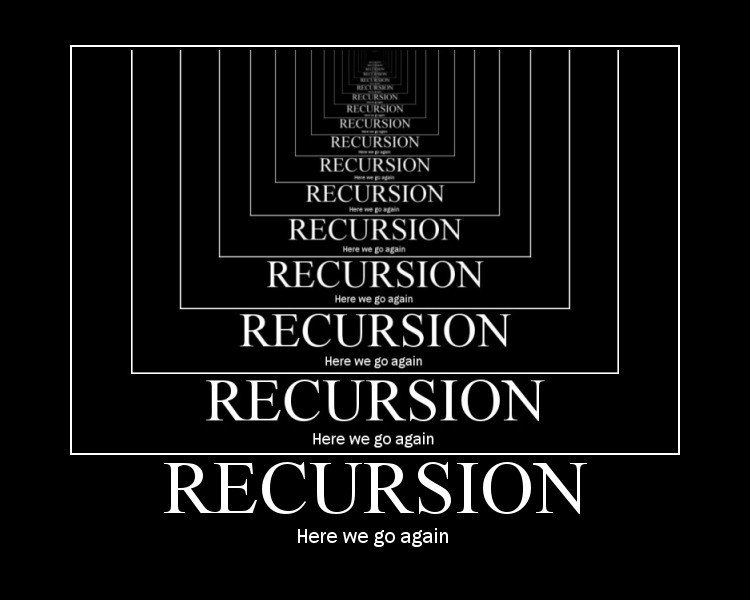
Objectives
- Define Recursion
- Define and identify "base cases"
- Define and identify a "recursive step"
- Write a recursive function
Recursion Is
"an equation that recursively defines a sequence or multidimensional array of values, once one or more initial terms are given: each further term of the sequence or array is defined as a function of the preceding terms."
Mathematically
wtf does that mean?
Recursion Is
A function which calls itself.
function recursive() {
// Boom goes the call stack
recursive();
}Lets Run This Code...
Recursion Is
Analogous To

Recursion Is
"the repeated application of a recursive procedure or definition."
For example: A recursive definition.
Recursively
Why its Useful
It turns out that many problems can be solved by applying the same logic on a subset of the original problem.
As we get into lists, trees, and graphs recursive logic will become increasingly valuable.
Example: Fibonacci Sequence
Fib(0) = 1
Fib(1) = 1
Fib(n) = Fib(n-1) + Fib(n-2)
This is a complete definition of the Fibonacci sequence:
Example: Fibonacci Sequence
Fib(0) = 1
Fib(1) = 1
Fib(n) = Fib(n-1) + Fib(n-2)
These two are called "base cases" and prevent us from recursing infinitely:
Example: Fibonacci Sequence
Fib(0) = 1
Fib(1) = 1
Fib(n) = Fib(n-1) + Fib(n-2)
This is called the "recursive step" which computes the sub-solutions.
Example: Fibonacci Sequence
Fib(5)
Fib(4) + Fib(3)
Fib(3) + Fib(2) Fib(2) + Fib(1)
Fib(2) + Fib(1) Fib(0) + Fib(1) Fib(0) + Fib(1)
Fib(0) + Fib(1)
Example: Fibonacci Sequence
function fib(n) {
// First we're going to do the base cases
if(n < 0) {
throw new Error("invalid input, negative n);
}
if(n === 0 || n === 1) {
return 1
}
}Example: Fibonacci Sequence
function fib(n) {
// First we're going to do the base cases
if(n < 0) {
throw new Error("invalid input, negative n);
}
if(n === 0 || n === 1) {
return 1
}
// If it wasn't a base-case, apply the recursive step
return fib(n-2) + fib(n-1);
}Planning Recursion
Always start with the base cases.
In Fibonacci that was n === 1 or n === 0
Next, think about the recursive step as getting your algorithm one step closer to a base-case
In Fibonacci, that was decrementing n before calling fib again.
Example: Binary Search
Find the position of 3 in this list:
[0,1,1,2,3,4,5,6,12,90]
->
[0,1,1,2,3]
->
[2,3]
->
Found it.
Example: Binary Search
Lets think about how we *might* code binary search recursively.
Questions?
Recursion
By Tyler Bettilyon
Recursion
- 1,572



